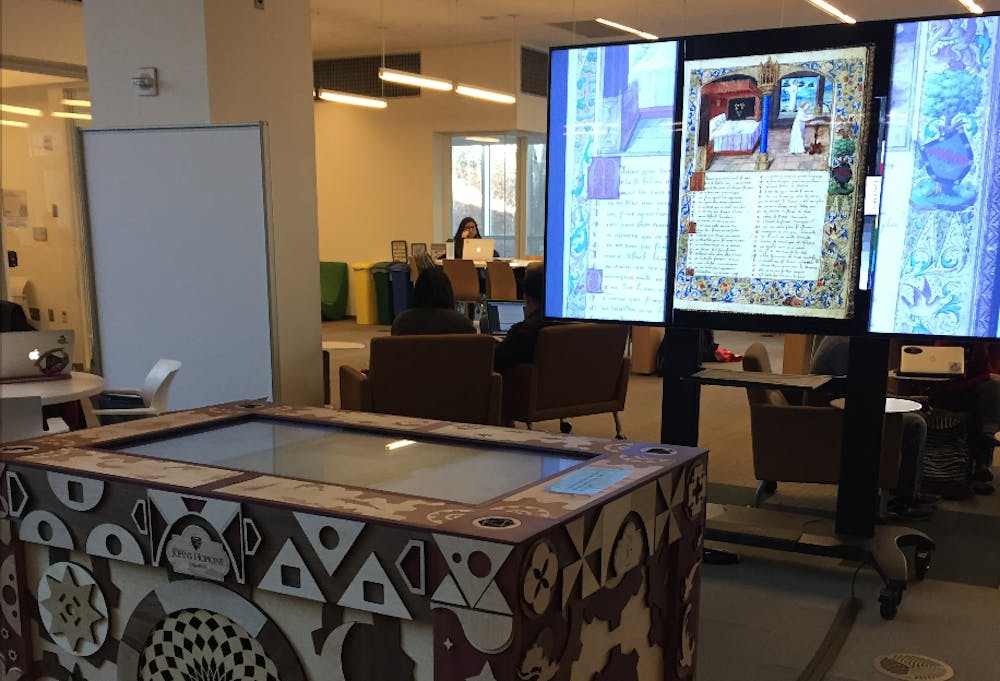Returning to Brody Atrium after a restful winter break, you might have noticed the absence of the BALAUR Wall. In its place lies a mysterious wooden box with intricate designs carved into its sides. As you approach the box you see that it appears to control the screen in front of it, which displays some video game-like sequence.
This odd contraption is the Kata Interactive Table, designed by the Kata Design Studio to help patients recovering from stroke and other neurological impairments recover motor capabilities through multiplayer gaming. Students and stroke survivors alike can use the table to destress, learn and simply have fun. The Kata Table is one of many innovative devices that are part of the Kata Design Project, which fuses neuroscience knowledge and computing concepts in its technologies to provide better therapeutic treatments for patients.
The News-Letter had the opportunity to interview Sayeed Choudhury, the Hodson Director of the Digital Research and Curation Center at the Sheridan Libraries.
The News-Letter: Why did the library decide to replace the BALAUR/visual (viz) wall with the Kata Interactive Table rather than incorporate both?
Sayeed Choudhury: From the Library’s perspective, with both the previous and new viz wall, we hope to create new ways to interact with content, apps, games, etc. while raising awareness of library collections and services. With the previous viz wall, we worked with the Department of Computer Science in a largely experimental manner.
We wanted to learn more about what might engage students as they walked by the wall and how they wanted to interact with the content and games. While we learned a great deal, we also realized that we could do a better job in terms of engaging students, lowering the barrier for use and creating a better software framework that could be extended over time.
We decided it would be better to learn from these lessons and build a new system rather than incorporate the previous version. Our faculty partner for the previous viz wall, Greg Hager from Computer Science, introduced me to Omar Ahmad from the Kata Lab in the Department of Neurology. Their lab has some compelling ideas about how games can be used to help patients recover and rehabilitate from various types of trauma (such as a stroke).
Ahmad also pointed out that the barrier to using the previous viz wall was too challenging. The leap from walking by to using the gesture-based control system was too much. With the new interactive table and viz wall, students will eventually be able to interact using their mobile device, the touch screen, gestures and (eventually) virtual reality. Additionally it’s much easier to incorporate content from students. The first images on the screen saver come from the Homewood Photography student group.
N-L: How will the Kata Table add to student life at Hopkins and the library environment?
SC: There are two main ways in which I think the interactive table and viz wall will add to student life at Hopkins and the library environment: engagement and awareness. It starts as simply as providing a fun, relaxing way to take a break with the games. Eventually the Kata Lab will develop games that students will play with patients at Hopkins Hospital (and perhaps even other hospitals). While the students might be playing for fun, they will be helping patients recover and rehabilitate on the other end.
While the table and wall aren’t being used for games, the library and others will have an opportunity to showcase digital content, events, exhibits, etc. From a service perspective, we imagine that while you’re viewing library collections, we could also display information about librarians who could help students use those collections and discover other relevant content. We will create digital versions of the physical exhibits you see within Brody and MSEL.
Student groups like the Homewood Photography club will be able to share their images, and groups of students and faculty may be able to use the displays for classes or to showcase research results.
All of these efforts will hopefully raise awareness about all that the library has to offer in the digital realm, what other students are doing on campus and the amazing research and treatment taking place at the School of Medicine and Hopkins Hospital. Given the new software framework, we have a much greater capability and flexibility in moving the displays in new directions.
N-L: Will the Kata Interactive Table stay at the Library permanently?
SC: While the library manages the space, we very much feel that the students “own” it. Brody was created very much in mind with student needs. Assuming the table and wall meet the goals and students find value in it, we will keep in the Library permanently.
If not, then we’ll consider how we might adapt it or — as we did with the previous system — consider taking it down.
These are very much early days with the new system but we think it has a lot of potential. We welcome feedback and participation from students. With the new table and viz wall, we hope that students will partner with us in its usage and further development.
The News-Letter also had the opportunity to speak to students who used the Kata Interactive Table. Some students are interested in the idea that the box may eventually have medical implications.
“It seems really innovative, and I’d like to know more about how it helps stroke survivors recover,” freshman Laurent Park said.
Other students are looking forward to seeing the box be implemented beyond Brody Atrium.
“I think it’s amazing that Hopkins is so forward-thinking even in the way it uses student spaces,” freshman Sinja Fan said. “Perhaps in the future, innovative technology like the Kata Interactive Table will become common in public spaces, truly connecting, entertaining and engaging students and community members alike.”

















